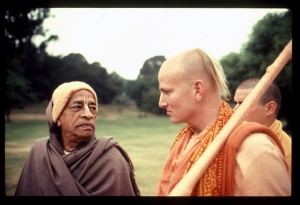CC Adi 13.89 (1975)

A.C. Bhaktivedanta Swami Prabhupada
TEXT 89
- caudda-śata sāta-śake māsa ye phālguna
- paurṇamāsīra sandhyā-kāle haile śubha-kṣaṇa
SYNONYMS
caudda-śata sāta-śake—in 1407 of the Śaka Era (A.D. 1486); māsa—month; ye—which; phālguna—of the name Phālguna; paurṇamāsira—of the full moon; sandhyā-kāle—in the evening; haile—there was; śubha-kṣaṇa—an auspicious constellation.
TRANSLATION
Thus in the year 1407 of the Śaka Era (A.D. 1486), in the month of Phālguna [March-April], on the evening of the full moon, the desired auspicious moment appeared.
PURPORT
Śrīla Bhaktivinoda Ṭhākura, in his Amṛta-pravāha-bhāṣya, has presented the horoscope of Śrī Caitanya Mahāprabhu as follows:
śala 140710222845
dinam
7 11 8
15 54 38
40 37 40
13 6 23
The explanation of the horoscope given by Bhaktivinoda Ṭhākura is that at the time of the birth of Lord Caitanya Mahāprabhu the constellations were situated as follows: Śukra (Venus) was in Meṣa-rāśi (Aries), in the constellation of Aśvinī; Ketu (the ninth planet) was in Siṁha-rāśi (Leo), in Uttaraphalgunī; Candra (the moon) was in Siṁha-rāśi, in Pūrvaphalgunī (the eleventh lunar mansion); Śani (Saturn) was in Vṛścika-rāśi (Scorpio), in Jyeṣṭhā; Bṛhaspati (Jupiter) was in Dhanu-rāśi, in Pūrvāṣāḍhā (Sagittarius); Maṅgala (Mars) was in Makara-rāśi (Capricorn), in Śravaṇā; Ravi (the sun) and Rāhu were in Kumbha-rāśi (Aquarius), in Pūrvabhādrapāda; and Budha (Mercury) was in Mīna-rāśi (Pisces), in Uttarabhādrapāda.. The lagna was Siṁha.